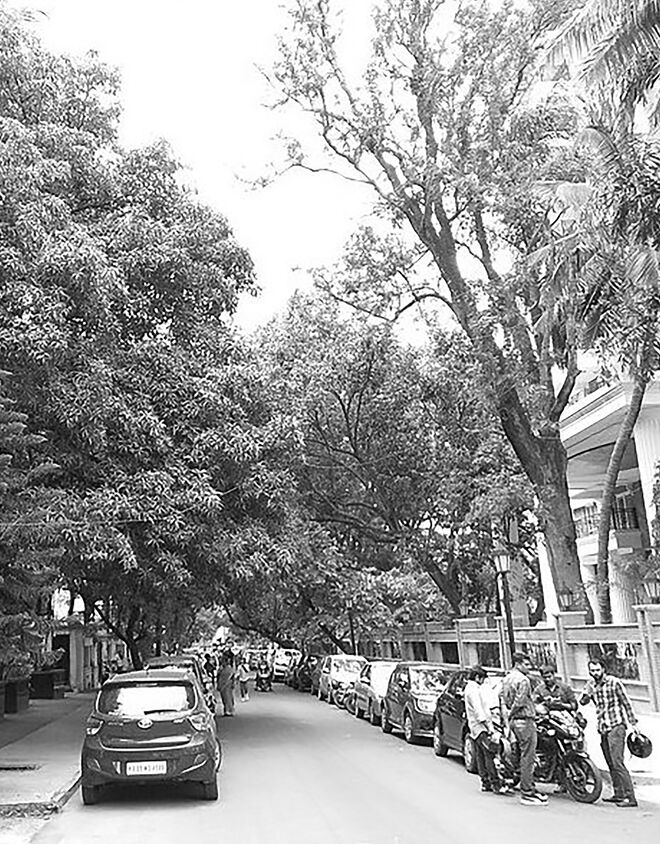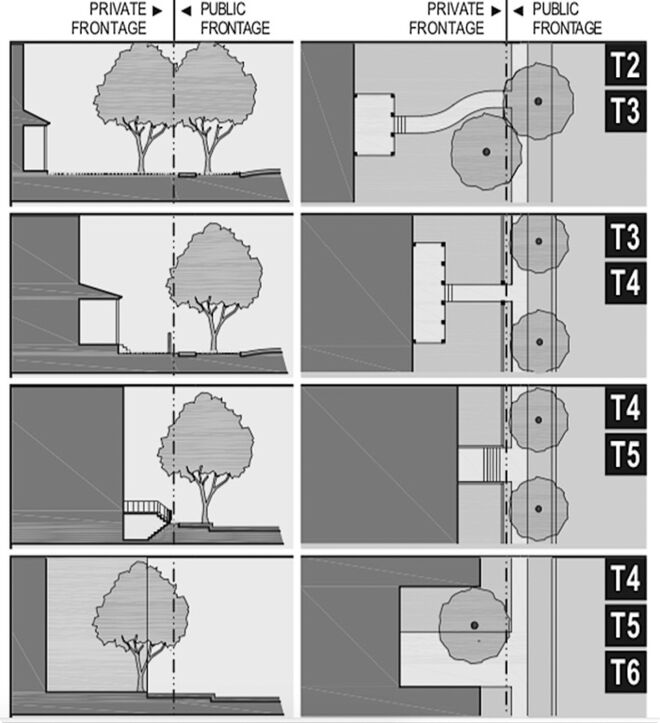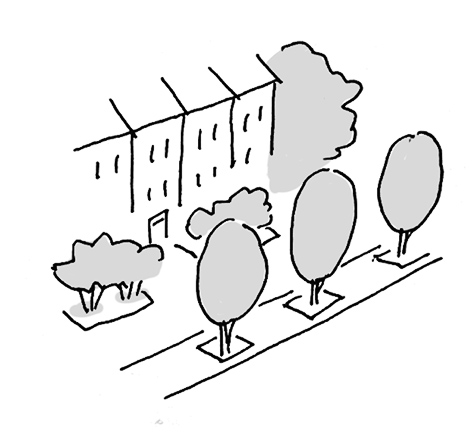8.3. Street Trees
Aus Pattern Language Wiki
Along your Walkable Streetscape and Perimeter Block, assure that there is attractive vegetation.
Problem-statement: Few element provide more benefits to neighborhoods and cities than street trees. But there are challenges with their placement and maintenance.
Discussion: Sometimes the assumption about street trees is that they will march down every street, identical species at a regular spacing. But they need not have such a relentless pattern. For example, some trees might be of a distinctive species, producing a particularly beautiful flower or leaf color. The pattern of trees can also vary, sometimes alternating, sometimes grouping into natural patterns, or forming “bosques” of parallel rows.
There are other considerations for street trees as well, and one of the most important is the ability of trees to survive with low maintenance in what can be a stressful urban environment and climate. Many neighborhoods have lost huge numbers of trees due to disease (for example, Dutch elm disease). It is therefore important to pick hardy, climate-appropriate species, and mix them so that a die-off of any one species will not denude the entire street.
Street trees must also be placed to avoid interfering with overhead power lines, and with buried utilities. So-called “root guards” — barriers that force the roots to travel downward and not sideways — can protect utilities as well as concrete sidewalks. Trees that are in vulnerable locations, prone to damage.
Therefore:
Plan streets with street trees at their edges and medians, varying in species and in placement as appropriate for building frontages. Place trees to avoid conflicts with overhead power lines, and protect buried utilities with root guards if needed. Protect them with tree guards when young.
Use street trees to create Framing of vistas. Coordinate placement of street trees with a Form-Based Code…
¹ A review of benefits and challenges can be found at Mullaney, J., Lucke, T., & Trueman, S. J. (2015). A review of benefits and challenges in growing street trees in paved urban environments. Landscape and Urban Planning, 134, 157-166. A shorter overview of some of the same issues is provided by Dan Burden, at Burden, D. (2006). 22 benefits of urban street trees. Orlando FL: Glatting Jackson and Walkable Communities, Inc. Available on the Web at http://www.walkable.org/download/22_benefits.pdf
Mehaffy, M. et al. (2020). STREET TREES (pattern). In A New Pattern Language for Growing Regions. The Dalles: Sustasis Press. Available at https://pattern-language.wiki/.../Street_Trees
SECTION I:
PATTERNS OF SCALE
1. REGIONAL PATTERNS
Define the large-scale spatial organization…
1.4. 400M THROUGH STREET NETWORK
2. URBAN PATTERNS
Establish essential urban characteristics…
3. STREET PATTERNS
Identify and allocate street types…
4. NEIGHBORHOOD PATTERNS
Define neighborhood-scale elements…
5. SPECIAL USE PATTERNS
Integrate unique urban elements with care…
6. PUBLIC SPACE PATTERNS
Establish the character of the crucial public realm…
7. BLOCK AND PLOT PATTERNS
Lay out the detailed structure of property lines…
8. STREETSCAPE PATTERNS
Configure the street as a welcoming place…
9. BUILDING PATTERNS
Lay out appropriate urban buildings…
10. BUILDING EDGE PATTERNS
Create interior and exterior connectivity…
10.1. INDOOR-OUTDOOR AMBIGUITY
SECTION II:
PATTERNS OF MULTIPLE SCALE
11. GEOMETRIC PATTERNS
Build in coherent geometries at all scales…
11.2. SMALL GROUPS OF ELEMENTS
12. AFFORDANCE PATTERNS
Build in user capacity to shape the environment…
13. RETROFIT PATTERNS
Revitalize and improve existing urban assets …
14. INFORMAL GROWTH PATTERNS
Accommodate “bottom-up” urban growth…
15. CONSTRUCTION PATTERNS
Use the building process to enrich the result…
SECTION III:
PATTERNS OF PROCESS
16. IMPLEMENTATION TOOL PATTERNS
Use tools to achieve successful results…
16.2. ENTITLEMENT STREAMLINING
16.3. NEIGHBORHOOD PLANNING CENTER
17. PROJECT ECONOMICS PATTERNS
Create flows of money that support urban quality…
17.4. ECONOMIES OF PLACE AND DIFFERENTIATION
18. PLACE GOVERNANCE PATTERNS
Processes for making and managing places…
18.3. PUBLIC-PRIVATE PLACE MANAGEMENT
19. AFFORDABILITY PATTERNS
Build in affordability for all incomes…
19.1. INTEGRATED AFFORDABILITY
20. NEW TECHNOLOGY PATTERNS
Integrate new systems without damaging old ones…
20.2. RESPONSIVE TRANSPORTATION NETWORK COMPANY


